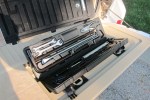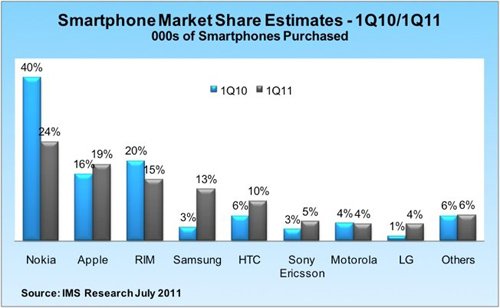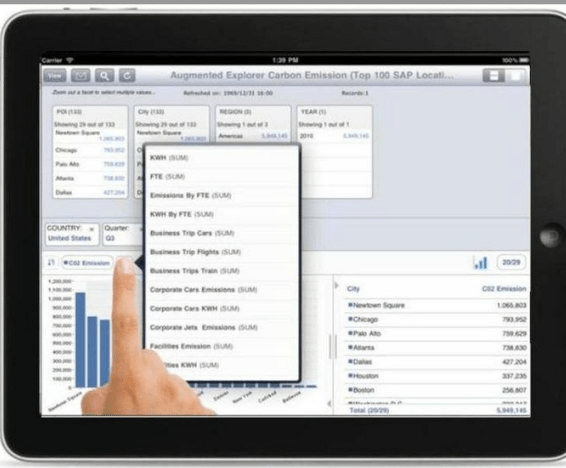The Latest from TechCrunch
The Latest from TechCrunch |  |
- eBay, PayPal Reveal More Details On X.Commerce Platform For Developers, Partners With Kenshoo
- It’s Dangerous To Go Alone: SimpleGeo And Urban Airship Partner Up For Location Notifications
- The Seemingly Unanswerable Question: Can The Government Use Location Data To Hunt Us Down?
- AHAlife Raises $6M To Curate And Sell Hard-To-Find Products From Around The World
- T-Mobile Buys Good Will With Gift Cards For Customers
- Amazon’s Market Cap Passes $100 Billion
- Founder Office Hours With Chris Dixon And Josh Kopelman: Schedit
- Is European VC Really Out-performing The US, Or Is This Wishful Thinking?
- An “Anomaly” Gives Star Wars Prop Maker The Opportunity To Sell His Original Design
- Review: The Lexus LX 570 is An All-Terrain Electronic Fun House
- The Selectric: Typewriter Of Kings
- Netflix Lands Licensing Deal With CBS For Canadian And Latin American Subscribers
- Motorola Droid X2 Gets Bumped Up To Android 2.3 Gingerbread
- MacBook Air Killers? First Batch Of PC Ultrabooks To Carry An Ultra-Pricetag
- TribeHR Raises $1 Million To Help Small Businesses Manage Human Resources
- Smartphone Sales Will Hit 420 Million In 2011, To Take 28 Percent Of The Total Phone Market
- AdSense For Images Pixazza Rebrands As Luminate, Launches Platform For In-Image Apps
- iOS 5 To Have Powerful Face Detection
- SAP Now Allows Businesses To Layer Big Data With Google Maps And Earth
- Daily Crunch: Handset
| eBay, PayPal Reveal More Details On X.Commerce Platform For Developers, Partners With Kenshoo Posted: 27 Jul 2011 09:08 AM PDT Earlier this year, eBay and PayPal decided to merge their API and developer platform into a combined open platform business, X.commerce. At the time, eBay, which owns PayPal, wanted to developers one ecommerce solution that would offer a "complete approach" to online and offline business. Of course, since then eBay has acquired open source e-commerce storefront platform Magento as well as e-commerce giant GSI Commerce. Together, eBay, PayPal, Magento and GSI will be the pillars of the X.commerce platform, which will be revealed at eBay’s X.commerce Innovate 2011 conference in November. At last year’s Innovate conference, PayPal revealed its micropayments digital goods product. PayPal and eBay, have more than 200,000 developers building off the two platforms, plus the 450,000 Magento developers added via the acquisition. PayPal’s Director of Communications Anuj Nayar explains that X.commerce will feature a “fabric” that stitches the platform together to create new experiences for retailers and their customers. eBay will be announcing a number of partnerships at the conference that will be a part of this fabric, but we know a few of these partners already. Earlier this year, eBay announced that X.commerce developers will be able to access deep analytics from Adobe’s Omniture platform. And today, eBay is revealing a partnership with Sequoia-backed Kenshoo – the Sequoia backed digital marketing software company. Kenshoo will be supplying its online marketing software platform developers to help drive consumer awareness of their storefront, whether it's mobile, online or in-store. For example, Kenshoo can extract the inventories of merchants, and help with SEO as well as create meaningful leads. Currently, Walmart, Target, Sears, Leows, Zappos, and Amazon use Kenshoo’s platform. Nayar says that the Kenshoo and Adobe partnerships are just the “tip of the iceberg” for the X.commerce platform and that many more deals will be revealed in October. We know eBay has major ambitions when it comes to dominating local and mobile commerce and engaging developers on its marketplace, PayPal and Magento platforms are part of this strategy. PayPal has been able to create a local following of developers, but the key for eBay’s expansion is to connect the dots on an open platform between PayPal and all of the company’s acquisitions. The first 50 TechCrunch readers to use the code, ‘INN2011TC’ here will receive $100 off their registration for Innovate 2011. Founded in 1995 in San Jose, Calif., eBay connects millions of buyers and sellers globally in the world’s largest online marketplace, utilizing PayPal to ensure secure transactions. The company...  |
| It’s Dangerous To Go Alone: SimpleGeo And Urban Airship Partner Up For Location Notifications Posted: 27 Jul 2011 09:00 AM PDT Over the past couple of years, push notifications have become a vital part of the mobile picture. There are so many apps, and so much that you can do on smartphones, that you need a system to alert you when something comes up that you’ll want to know about. But these notifications are still not a particularly easy thing for developers to wrap their heads around and implement. That’s why Urban Airship exists. And all of the same things can be said about location. Which is why SimpleGeo exists. So it seems to be a good match that the two of them are hooking up for a partnership. As they’ll announce as OSCON (the open source developer conference) today, Urban Airship and SimpleGeo have signed a long-term strategic partnership agreement. Given the wide-range of services that both companies offer, this could ultimately mean many things. But the core idea is to provide developers with a simple way to offer location-aware push notifications in their applications. What if you enter an area that happens to be near a deal that one of your apps is offering? Such a partnership could make it easy for that app to implement a way to send it to you when it matters most — when you’re there, for example. Or what if it’s a heatwave in your city and an app on your phone can recognize this and send you a message to head somewhere for a cool treat? Those kind of things will be possible. “Location has long been the Holy Grail,” says Scott Kveton, CEO of Urban Airship. “On mobile, the potential is there for sure but thus far execution has been extremely poor. So we have taken our time to make sure we partner with the location experts to align with our vision of real-time, context-aware, personalized push notifications. This will make apps a lot more useful for everybody — marketers, consumers and developers alike,” he continues. Rob Bailey, SimpleGeo’s VP of Biz Dev, cuts right to the heart of why this really matters for both companies though. “Geo-targeted notifications are a massive area for opportunity in revenue for SimpleGeo and Urban Airship.” Such functionality is a big value proposition for a lot of app makers. And many will undoubtedly be willing to pay for it. “We’re very excited to be going after this opportunity together,” Bailey continues. No doubt. The two sides say the functionality provided by the parternship will be rolling out in phases. Phase one will start in Q3 and will see Simple Geo parse location out of Urban Airship’s notifications. This information can then be passed and used through the APIs. Down the road, things will go even deeper, the two sides suggest. As long as Urban Airship keeps making signs like the one above, I’m all ears for anything they have to say. [image via twitter/harryh] |
| The Seemingly Unanswerable Question: Can The Government Use Location Data To Hunt Us Down? Posted: 27 Jul 2011 08:47 AM PDT You remember Locationgate, right? It was that massive national scandal that left both Apple and Google at the center of our discontent, after two German researchers discovered that the iPhone tracks and stores location data automatically. The scandal has spurred numerous investigations into where we should draw the line when it comes to location tracking, and one in particular garnered the wisdom of the NSA's Matthew Olsen, National Counterterrorism Center lead and NSA general counsel. At a confirmation hearing in the Senate Select Committee on Intelligence, Olsen answered the question we had all been asking for a while: can the government use our location data to track us? The WSJ reports that Senator Ron Wyden of Oregon posed the question, asking if The Man can "use cell site data to track the location of Americans inside the country." Olsen's response was ambiguous at best, although he seemed to suggest that the government does in fact have that authority: "There are certain circumstances where that authority may exist," said Olsen. "It is a very complicated question." Well that just about clears it up then, doesn't it? Remember the good old days when the feds actually had to do a little work to find suspected criminals? Good times. Anyways, since Olsen's answer fell short of any sense of clarity, the "intelligence community" — another awesomely vague reference — intends to write up a memo that will actually answer the question. A California senator, Dianne Feinstein, asked that the memo be completed by the time the committee reconvenes in September. The question posed by Senator Ron Wyden inherently steps into the Fourth Amendment's territory. The Fourth Amendment promises protection and privacy for both the citizen and his or her possessions against unreasonable searches. Whether or not that search is unreasonable is based on the searchee's subjective and objective beliefs about their own privacy (among other things). A criminal may subjectively believe that his old cigarette butt is private property but that won't stop Law & Order detectives from using it to nab DNA evidence. However, if society as a whole collectively believes that the expectation of privacy is reasonable, then evidence collected from the search must be thrown out. In other words, if dirty secrets aren't kept in a private place, you can say goodbye to your privacy protection. But are phones private? We lock them up with passwords, and we certainly don't "borrow" each other's phones the way we do clothes, books, and DVDs. So how can data from our private phones be used to track us down? The reason Locationgate was so upsetting to so many people is because it shattered the perception that our phones are locked down little safes that hold and guard all of our secrets. But Apple and Google both maintain that the data collected is encrypted and anonymous if sent back to the company, which again confirms our original thoughts: our phones are private and it is only reasonable to expect privacy when it comes to your phone. Hopefully, that memo will read the same. |
| AHAlife Raises $6M To Curate And Sell Hard-To-Find Products From Around The World Posted: 27 Jul 2011 08:00 AM PDT AHAlife, an e-commerce site for hard-to-find and exclusive luxury lifestyle products, has raised $6 million in funding led by DCM with FirstMark Capital participating in the round. This brings AHAlife’s total funding to $9 million. As we wrote in our review of the site, AHAlife introduces one new product a day in editorial format through its email list, tells the story about how the product was made, who made it, and where it came from while allowing you to also purchase the product. Products span fashion, food, beauty, travel, accessories, home décor, tech, and travel experiences. Products range from a handmade Crocodile iPad cover to stylish energy saving lightbulbs. What makes the site compelling is the blend of content, commerce, and curation in AHAlife’s platform. Celebrity curators on the site include Tim Gunn, Wendi Murdoch, Donna Karan Daniel Boulud, Bobbi Brown, Petra Nemcova, Foodspotting's Soraya Darabi, Cynthia Rowley, and Tina Brown. Since the company launched its site in September 2010, AHAlife has grown its subscriber base by almost 10 times. The new capital will be used to curate more merchandise, build out the technology and content, and for subscriber acquisition. AHAlife is a content + commerce destination for unique luxury products from around the world, collectively curated by a group of ‘tastemakers.’ The site features a new hand-selected item each...  |
| T-Mobile Buys Good Will With Gift Cards For Customers Posted: 27 Jul 2011 07:23 AM PDT How does that old phrase go? "There ain't no such thing as a free lunch?" Intellectual heavyweights like Milton Friedman and Robert Heinlein got a fair bit of mileage out of the quote, and it seems at least one person over at T-Mobile HQ has heard it. The result? According to TmoNews, T-Mobile has begun to send out free $25 gift cards for use on anything (short of bill payments) inside T-Mo corporate stores. Sounds like a free lunch so far, right? The gift cards have been trickling out into the public for at least a few days now, but nothing solid has turned up about exactly which customers are able to benefit. If typical carrier logic applies, I'd wager T-Mobile would focus on getting these out to folks nearing the end of a contract term, or to those who just re-signed or recently activated. Still, there's probably much more at play here. If a good database marketer was involved, then I'd expect them to have a precise subset of customers they deem worthy of free T-Mobile money. Depending on the criteria (years with company, average bill amount, recency of last contract extension, etc.) are found to be most important, they'll generate a list of deserving people based on how well they rank in each criterion. In short, they would have found a way to send those gift cards to those most worth it for T-Mobile to please. On top of that, there's usually a temptation to spend more than originally expected when gift cards come into play, so T-Mobile certainly aims to gain from this stunt. Regardless of motive, all your T-Mobile customers out there should keep an eye on your mailboxes, just in case. |
| Amazon’s Market Cap Passes $100 Billion Posted: 27 Jul 2011 07:20 AM PDT
Amazon’s sales for the quarter neared $10 billion, an increase of 51 percent from the same quarter in 2010. Net income decreased 8% to $191 million in the second quarter, or $0.41 per diluted share, compared with net income of $207 million, or $0.45 per diluted share, in second quarter 2010. But despite this decline in net income, Amazon was able to beat analyst expectations. And the company’s stock is rallying this morning, thanks to bullish investors. Shares reached as high as $227.20 today, which is an all-time high for the company. To put the $100 billion market cap in perspective, Amazon has surpassed HP’s valuation, which is currently $76 billion. eBay’s market cap is $43 billion. Amazon.com Inc. (AMZN) is a leading global Internet company and one of the most trafficked Internet retail destinations worldwide. Amazon is one of the first companies to sell products deep...  |
| Founder Office Hours With Chris Dixon And Josh Kopelman: Schedit Posted: 27 Jul 2011 07:10 AM PDT “What do investors look for in a beta? What are the key metrics?” That is the question Omar Tellez poses to Chris Dixon of Founder Collective and Hunch and Josh Kopelman of First Round Capital in this episode of Founder Office Hours (a special format of Founder Stories we are trying out). Tellez is the CEO of Sched.it, a social online calendar app getting ready to launch. Kopelman notes that “investors are always tempted and teased by large numbers,” but cautions that any site can manufacture a bump in visitors. “The real data is retention and repeat usage. Instrument your site to track that data,” he advises. Services like Kissmetrics and RJMetrics are designed to track different cohorts of users, for instance. Dixon agrees that focusing on “vanity metrics” will get startups nowhere. It’s much better to try to understand the “users you lost” and what excites your most engaged users. And don’t be afraid to launch a “minimal viable product” and retool quickly. “If you aren’t embarrassed by your first product, you have launched too late,” he says. Learn from your early mistakes, improve the product, stay lean, and keep moving forward quickly. And what about limiting access to the beta to create a sense of exclusivity like at a nightclub? If you can do that, fine. But the “velvet rope works for four nightclubs,” notes Dixon, and everyone else has to beg people to come in from the sidewalks. If you enjoy watching Founder Office Hours, be sure to check out the first one with Profitably’s founder and Paul Graham’s Office Hours at Disrupt NYC, the the original inspiration for this show. |
| Is European VC Really Out-performing The US, Or Is This Wishful Thinking? Posted: 27 Jul 2011 06:44 AM PDT
|
| An “Anomaly” Gives Star Wars Prop Maker The Opportunity To Sell His Original Design Posted: 27 Jul 2011 06:42 AM PDT Andrew Ainsworth, the creator of the original Storm Trooper gear in Star Wars, won an infringement case against Lucasfilm allowing him to make and sell his $3,000 helmets without suffering the sting of litigation. Ainsworth made the original armor in 1976 and now sells it on his site, SDSProps.com. The case has been brewing since 2009 when Lucasfilm sued in the US and then in the UK. An anomaly in the law, writes the BBC, allowed Ainsworth to classify these as functional rather than artistic items, “under which the creative and highly artistic works made for use in films… may not be entitled to copyright protection in the UK” This means the company will add new and improved items to its already impressive line of storm-trooper gear, allowing Star Wars fans to, in the immortal words of Han Solo, “take us up to warp speed, Mr. Sulu” when it comes to A New Hope memorabilia. |
| Review: The Lexus LX 570 is An All-Terrain Electronic Fun House Posted: 27 Jul 2011 06:21 AM PDT It floored me to think that here I was, cruising down this familiar two-track at nearly 60 mph. This is the route to one of my tree stands and generally a trip done in my father-in-law’s Ford F150. But my teeth were still intact and I didn’t feel like the trail was crushing my spine. I was floating along in this $89k Lexus flagship, cooled by air-conditioned seats, jamming to Sublime on Rdio over a Bluetooth link to my Droid X. The windows were down, the sunroof open and I have two bottles of water in the air-conditioned cooler box directly under my right elbow. Life was good. The 2011 Lexus LX 570 served me well over the last week. It performed admirably as a camping utility vehicle in the backwoods of Michigan and equally as well around town. I don’t think I’ve ever been more satisfied with a vehicle that has a potential deal breaker.
That’s how I felt during my time with the Lexus LX 570. It’s just too nice of a vehicle to get really dirty. The fact that it wasn’t mine helped counter that feeling as I didn’t have to worry about the suspension 20,000 miles down the road. I wanted to take the LX 570, with its 9 inches of ground clearance and automated crawl control into something extreme, but it just didn’t feel right (that and I couldn’t find any suitable location). Besides, that sort of tomfoolery is best reserved for its less fancy, but similarly capable cousin, the Toyota Land Cruiser.
It has everything: a 19 speaker Mark Levinson audio system, rear seat entertainment with remote, Bluetooth and USB connectivity. There are four heated and cooled seats to match the four zone climate control. An around the vehicle camera system is optional, which with a vehicle of this size, is equally important in a parking lot as it is off-roading. A powered split rear lift gate opens revealing power controls to fold up the back row of seats. The LX 570 has adaptive cruise control dubbed by Lexus as Dynamic Radar Cruise Control. There’s a powerful 383-horsepower engine paired to a silky six-speed sequential-shift automatic transmission. With a curb weight of 5,995 lbs, it’s three tons of fun.
This isn’t a bad thing per se. It allows the driver to enjoy the opulence within. The seats are amazing and I’m saying that after driving 400 miles with my four-year old constantly kicking the headrest. They’re just that good. The four zone climate control has what might be the coldest air conditioning on the planet and even an air filter system that helps to remove allergens, air particles and the general stank of camping.
When you finally find a station and cue up a good song, the Mark Levinson audio system will make you forget about all past transgressions. It didn’t matter what type of music I played, it shined on this system. The highs are crisp and tight. The lows are strong enough to embarrass many aftermarket solutions. This shouldn’t be surprising, though. Mark Levinson is known for its powerful audio systems and the system used in the LX 570 spreads 450 watts over 19 speakers at less than .1% THD. It’s impressive but still doesn’t make up for the sorry infotainment system. Features are not enough these days to make up for a sorry user experience. Automakers seemingly have had a hard time transitioning from buttons to touch and Lexus is not alone in having a poor UI. GM’s current system feels like it was made in the mid-nineties and the next-gen version is not much better. Ford’s MyFord Touch is impressive but also imposing to a novice. I’m not a fan of Honda’s or Chrysler’s. Audi and BMW got it right but did so without using a touchscreen. They instead employ a multi-function puck of sorts, which sort of implies that touch isn’t yet right for cars.
I’ve always enjoyed looking at an OEM’s top-tier SUV like the LX 570. It’s a solid barometer for the automaker as its designers, engineers, and the bean counters are freed from the traditional boundaries. There’s no reason to save weight or worry too much about fuel economy. There’s physically room to throw in every toy available and who cares about the end sticker price. In that sense the LX 570 serves the Lexus brand well. It has more raw capabilities than most other vehicles in its class and looks great doing it. It could be argued that it has more capabilities than necessary and a similarly equipped SUV can be had for tens of thousands less. That’s not the point. The LX 570 is at the top of the luxury SUV mountain.                |
| The Selectric: Typewriter Of Kings Posted: 27 Jul 2011 06:18 AM PDT Technologizer has a great retrospective on one of the most powerful information creation machines ever built – the IBM Selectric. The result of “seven years of research,” the Selectric typewriter entered the national consciousness in 1961 and died only when its creator, IBM, began to create its electronic replacement. In the end, this typewriter changed the way we thought of publishing and information sharing and redefined penmanship as a lost art. It cost about $3,000 in today’s dollars and feature a replaceable type ball that improved typing speeds immensely.
The coolest thing? IBM also built the Selectric Composer that used a wild, manual justification system to create camera-ready type on a machine that, at the time, cost the equivalent of $30,000 in US dollars. A real, electronic Selectric word processer cost $150,000. Check out the whole article here. |
| Netflix Lands Licensing Deal With CBS For Canadian And Latin American Subscribers Posted: 27 Jul 2011 06:14 AM PDT Netflix has just announced a deal with CBS Corporation to license TV shows from the media company for subscribers in Canada and Latin America. Netflix previously signed a two-year agreement with CBS for U.S. subscribers in Februaruy. Terms of the deal were not disclosed. CBS says that beginning in September (for only $7.99 a month), Netflix members in Canada will access seasons for “90210,” (the new one) as well as past seasons for a number of Showtime titles including “Californication,” “Dexter,” and “The United States of Tara.” Canadian members will also have access to shows like “Numb3rs,” “Sleeper Cell,” and “Twin Peaks.” Last September, Netflix debuted its service in Canada, with license agreements with Lionsgate, MGM Studios, Paramount Pictures, Sony Pictures Entertainment, Twentieth Century Fox and Universal Pictures, as well as Canadian distributors Alliance Films, Maple Pictures, eOne and Mongrel. But CBS was not on that list. Until today. Netflix, who announced in early July that it would be launching in 43 countries across Mexico, South America and the Caribbean later this year, will offer similar CBS programing to these customers including, “90210,” “Medium,” “Nurse Jackie,” “Californication” and “Dexter,” as well as “Star Trek,” “Star Trek: The Next Generation,” “Charmed,” and “Twin Peaks.” Clearly this content isn’t new, but it does offer these international subscribers access to TV shows and movies. For Netflix, striking these international deals quickly is going to be key to the company’s growth beyond the U.S., where it already has major deals in place. With more than 23.3 million members in the United States and Canada, Netflix, Inc. is the world's leading Internet subscription service for enjoying movies and TV shows. For $7.99...  |
| Motorola Droid X2 Gets Bumped Up To Android 2.3 Gingerbread Posted: 27 Jul 2011 05:57 AM PDT The Droid X2 is one of those phones that you learn to quickly stop judging by its bezel. Despite having nearly identical hardware to its less powerful predecessor, the handset shipped with some pretty notable under-the-hood improvements. But one thing was still missing: Gingerbread. Luckily, Verizon has released the Android 2.3 Gingerbread update this morning so the Droid X2 can continue to masquerade as a 2010 handset while performing like its fresh out of the box. Of course, improved copy and paste, faster performance, and more detailed battery information are all in tow as part of the overarching Gingerbread update, but Motorola has baked in some goodies of its own, too. The MotoBlur UI will now sport new colors and widgets, and the software-based keyboard has been enhanced with multitouch. The camera app will now allow geo-tagging of photos and the calendar app has also seen some improvements. The update notification should appear automatically on the Droid X2, but if you're feeling antsy go ahead and check for an update manually in the System Updates portion of your Settings app. But be sure to tap into a WiFi network first, or you may be waiting a while: the update is 101MB. [via Android Central] |
| MacBook Air Killers? First Batch Of PC Ultrabooks To Carry An Ultra-Pricetag Posted: 27 Jul 2011 05:53 AM PDT Ultrabooks are supposed to be the PC’s answer to the MacBook Air. These notebooks are said to rock hardware platforms very similar to the Air’s but, you know, run Windows instead of OS X. The first crop from HP and Asus will likely hit during the fourth quarter of 2011 but won’t be Air-killers right away. They’re going to be too expensive. Ultra-thin Window notebooks aren’t new. Dell produced the Adamo XPS and MSI, among others, have been selling notebooks just slightly thicker than the Air for years. These upcoming so-called ultrabooks are different, though. They’re built around an Intel platform specifically designed for Air-thin notebooks. PC notebooks are supposed to be cheap. They’re supposed to cost less than comparable Mac notebooks even though their pricing often has nothing to do with Apple. PC notebook makers have been racing each other to the bottom. HP fights Dell. Toshiba battles Acer and Asus. Samsung goes at it with Sony. It’s intermarket warfare at its finest. Then there’s Apple, lazily cruising along the high road, seemingly unwilling to join the plunge downmarket. It’s least expensive computer, now the base model MacBook Air, costs hundreds more than HP’s cheapest notebook and only features a fraction of the raw computing power. But the Air is thin. And light. And has amazing battery life, quick wake-up speeds and all the traits that make for a great portable, which is something that the bargain HP cannot say. Intel threw PC makers a bone back in May when the chip maker unveiled the Ultrabook platform. Ultrabooks are supposed to be a PC MacBook Air with thin designs, tablet-like battery life, and enough power thanks to a 22nm Ivy Bridge processor. They are also supposed to cost less than the Air with a starting price under a $1000. Digitimes is reporting that last part isn’t going to hold true for the first batch. Unexpected low yields on key components are expected to cause Asus to price its first batch from $1,000 to $1,600. These models aren’t even built around the next-gen Ivy Bridge platform. Asus is using the current Sandy Bridge Core i5. The higher prices might just slow the overall adaption of the Ultrabooks as the higher price will likely cause consumers and retailers to shy away. They are going to be a hard sale with a price tag well north of $1,000 to buyers who often shop by silly specs like processing speed and hard drive space. Hopefully prices will come down and they will as long there’s a continued demand for the ultra-thin PC notebooks. During this early stage their best advertising will come from Apple. The average Best Buy shopper will no doubt gaze in wonderment at the Air. But then the shopper will eventually turn and wander back to the familiar world of Windows and cheap notebooks. |
| TribeHR Raises $1 Million To Help Small Businesses Manage Human Resources Posted: 27 Jul 2011 04:30 AM PDT TribeHR, a company that develops a human resources software for small businesses, has raised $1 million in seed financing from Matrix Partners. TribeHR offers a human resources software designed specifically for small and medium businesses. The SaaS simplifies and automates companies’ ability to track employee development, new employees, vacation and sick time, job postings, goal setting and much more. Pricing for the software ranges from $19 per month for up to 15 employees to $399 for an unlimited number of staff members. TribeHR will use the funds for product development and expand sales and marketing programs. Company: TRIBEHR Website: http://www.tribehr.com TribeHR is a web-based human resources management tool for small businesses (2-200 employees). Founded by Joseph Fung and Jesse Rodgers in Waterloo, Canada in 2009, it launched to a...  |
| Smartphone Sales Will Hit 420 Million In 2011, To Take 28 Percent Of The Total Phone Market Posted: 27 Jul 2011 03:18 AM PDT Thanks to the rise of the popular, non-business smartphone – namely any phone that supports app creation – carriers can expect to sell 420 million units this year, taking over a quarter of total phone sales away from “traditional” phones. The winners in this race? Samsung and Apple. The loser – by a long shot? Nokia, with a fall from 40% to 24% in one year.
It’s easy to forget that the mass of men (and women) lead lives of quiet non-smartphone ownership. Although we wouldn’t leave home without our Gingerbread-powered wundermachines, the market is still wide open for someone to slip in between the expensive smartphone and the nearly free dumbphone, a spot originally controlled by Nokia but now slowly being eroded by Samsung and LG. It’s also interesting to note that RIM fell 5% from 20% of the market since 1Q10. IMS also predicts 1 billion smartphone sales by 2016. |
| AdSense For Images Pixazza Rebrands As Luminate, Launches Platform For In-Image Apps Posted: 27 Jul 2011 02:59 AM PDT Pixazza, a Google Ventures-backed photo tagging service that has been compared to an "AdSense for Images," is rebranding as Luminate today, and debuting a new platform for in-image apps. As we’ve written in the past, Pixazza allows publishers to identify, tag and match products found within online images on their sites and then link them back to the inventories of Pixazza's network of advertisers. The service, which can be integrated in a site by adding a single line of code, allows consumers to browse the photos featured on a site and mouse over it to reveal information and pricing about similar products, and if desired, click to purchase. Through the company’s network of publishers, Pixazza now reaches more than 150 million unique users per month, and is seeing a rate of 30 billion image views per year. Pixazza currently works with over 4,000 publishers, including US Weekly, Hearst Digital Media and Access Hollywood. CEO Bob Lisbonne tells us that the rebanding of the company is an effort to convey that Luminate has a vision of making every image interactive, or luminous. Part of that vision is going beyond e-commerce as an engagement in an app, and providing other interactions within an image. Lisbonne explains to us that just as phones evolved from voice calls to smartphones with apps, images will soon provide more interactions beyond just views. So when a consumer sees the Luminate icon in the corner of an image, it indicates that the image is interactive. Consumers can mouse into the image and choose from a variety of image apps. These could include the ability to share an image or link to Twitter, discover statistics about their favorite athletes, see where to purchase similar products to those featured in a photo, access more information about a particular event, read more content about the people or places featured in an image, listen to music or see a movie trailer related to an image. The company;s applications will span a number of categories including commerce, information, social, organization, advertising, navigation, public service, and presentation. Currently, Luminate's platform offers applications such as Twitter Share, Facebook Share, and Email Share apps that give consumers the power to select what they want inside an image and share it with others; an information app called Annotation that allows publishers to quickly and easily tag any spot within an image and add information relevant to that image; a commerce app called Products, which enables consumers to mouse over the image and interact with tags on the picture; and an Advertising app that offers publishers a way to place relevant advertisements within an image. Luminate plans to roll out an API to developers to create apps for images in the near future. The startup, which has raised nearly $20 million in funding, faces competition from Stipple, Image Space Media, GumGum and others.
Company: PIXAZZA Website: http://www.pixazza.com/ Pixazza allows web publishers to turn their images into links where users can buy whatever is pictured.  |
| iOS 5 To Have Powerful Face Detection Posted: 27 Jul 2011 02:13 AM PDT After Apple’s purchase of face recognition software provider Polar Rose, we were unsure what Apple had planned. Now, thanks to a little 9to5mac digging we know that face recognition (FaceRec? FaceTimeRec? FaceSnatch?) will be baked deeply into iOS 5 and support a number of clever features including, potentially, the same wacky effects available in Lion’s Photo Booth app. Photo Booth, for example, uses Polar Rose’s technology to add tweeting birds flying around your head and to specifically change your eyes or nose rather than your entire face. This feature has been available with some webcams for a few years on Windows and is only now trickling over to the buttoned-up Mac world. The API supports a call to mouthPosition as well as left and right eye positions. There are no clear examples of these API calls in the OS itself but developers could, for example, use them to make better, more accurate fart apps and to take Talking Tom to dizzying new heights.  |
| SAP Now Allows Businesses To Layer Big Data With Google Maps And Earth Posted: 27 Jul 2011 02:00 AM PDT
SAP says its Location-based intelligence allows customers to analyze their businesses data in a geospatial context to understand the "where" of their information, as well as global, regional and local trends and how they are impacted by different scenarios. For example, a telecom operator will be able to use Google Earth and SAP software to perform dropped-call analysis and pinpoint the geo-coordinates of faulty towers. Or a state department of revenue will be able to overlay household tax information on a map of the state and group it at the county level to track the highest and lowest tax bases. And U.S. census data can be overlaid on a Google map of the country, grouped by state and drilled down on at the county level. Google also offers companies Google Earth Builder, which allows users to upload, process and store geospatial data in the Google Cloud. But SAP actually allows companies to bring in business analytics and data into Maps and Earth applications. SAP Americas is a subsidiary of SAP AG, the world’s largest business software company and the third-largest software supplier overall. SAP Americas’ corporate headquarters is located in Newtown Square,...  |
| Posted: 27 Jul 2011 01:00 AM PDT Here are some of yesterday’s stories on TechCrunch Gadgets: |
| You are subscribed to email updates from TechCrunch To stop receiving these emails, you may unsubscribe now. | Email delivery powered by Google |
| Google Inc., 20 West Kinzie, Chicago IL USA 60610 | |


 There’s been a lot of debate about the role of VC backing for startups in Europe recently, not least because we’ve been
There’s been a lot of debate about the role of VC backing for startups in Europe recently, not least because we’ve been 



